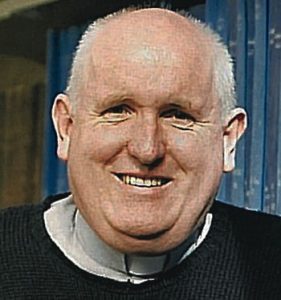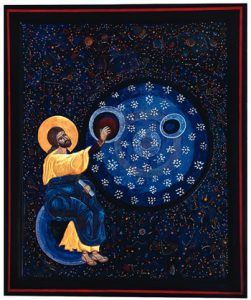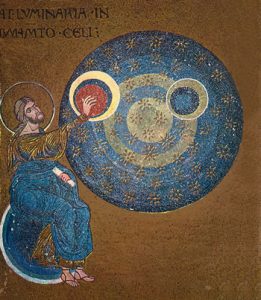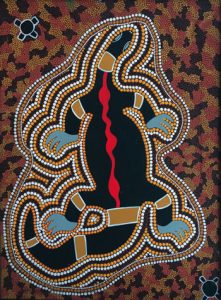Jesus Dreaming

Fr Merv Duffy SM
A Theological Reaction to Michael Galovic’s
Creation of Lights in the Heavens
The religious historian, Mircea Eliade, wrote of the ‘eternal return’ the religious belief that liturgy and prayer can put the believer in touch with the ‘mythical age’, the time when the foundational events of their faith occurred. In the words of institution in the eucharist, we do not merely remember what Jesus said and did, we make his saving death and resurrection present to us now. We live in the mundane world where ordinary time passes, but there is another time – the Great Time or Eternity that existed before the world began, will exist after it ends and, moreover, surrounds us now.
For Christians, our access to eternity is the person of Jesus Christ. He is our connection with God the Father, it is through Jesus that the Holy Spirit is sent to us. Our recurring prayer is “the Lord be with you”. Moreover, through Jesus we access all of Salvation History. Since he is the second person of the Trinity, he is present wherever the Holy Trinity is acting.
The first theologian to write of this was the Apologist, Justin Martyr, who died in 165 AD. St Justin wrote in his Dialogue with Trypho of what we now call ‘Christophanies’ – manifestations of Christ in the Old Testament. Justin wrote:
Permit me, further, to show you from the book of Exodus how this same One, who is both Angel, and God, and Lord, and man, and who appeared in human form to Abraham and Isaac, appeared in a flame of fire from the bush, and conversed with Moses.
‘Angel,’ which means ‘messenger,’ is no longer a term we use with reference to the Lord Jesus, but Justin, with his understanding of Jesus as the visible manifestation of the godhead and the Word of the Father, reads the Exodus stories of messengers and voices as referring to Jesus.

Creation of Lights in the Heavens,
by Michael Galovic
Hence, when the Hebrew Scriptures refer to God creating through his word “He spoke and they were made” (Psalm 33:9), Christian commentators on the scriptures saw this as the Logos-Christos, the second person of the Trinity, in action. For the fourth day of Creation the Genesis text reads:
Then God said, “Let there be lights in the expanse of the heavens to separate the day from the night, and let them be for signs and for seasons and for days and years; and let them be for lights in the expanse of the heavens to give light on the earth”; and it was so. God made the two great lights, the greater light to govern the day, and the lesser light to govern the night; He made the stars also. God placed them in the expanse of the heavens to give light on the earth (Genesis 1:14-17).
For the strictly monotheistic Hebrews it is the one God who set the lights of heaven, but the Church Fathers, reading the sacred text with the lenses of their Trinitarian faith see the Word of God at work.
Christian artists, charged with depicting eternity and creation and heavenly things, wanted to make it abundantly clear that their subject matter was in no way mundane or earthly. The artistic convention that the icon tradition developed was to set their figures against a golden background. Unlike the earthly realm, the holy figures appeared amidst an even gleaming light.
Mosaicists achieved the effect by making glass tesserae with gold foil on one side. It was an expensive and complicated process and it is amazing to see the huge extent to which it was employed in some of the great cathedrals of the world.

Monreale Mosaic,
12th Century
One such cathedral is that at Monreale, Cefalù, Sicily, Italy. It is one of the great masterpieces of the twelfth century. The ceiling, walls and apse are ablaze with Byzantine icon-style images set in a field of gold. Still photographs do not do justice to the way the background changes as you move and as the light source alters.
Monreale is the obvious influence on Michael Galovic. Icons influenced the mosaic of Creation in the Cathedral, and now Galovic’s icon is a homage to that masterpiece. Given that he is working in a different medium Galovic is remarkably faithful to his model. The circle of the heavens, the concentric shades of blue, even the placement of the stars is exact, though note that Galovic has omitted one particular star above the arm of the Christ. This could be a gesture of humility on the part of the artist – the disciple is less than the master – as well as an aesthetic choice to focus the interaction between the face of Christ and the light of the Sun.
The precision of the imitation adds impact to Galovic’s innovation. He, an expert at icon gilding, has taken away the gold of eternity and replaced it with something thoroughly Australian.
A common subject in Australian Aboriginal art is the Dreamtime, the time of the origins. A lizard may be depicted as the totemic ancestor figure who shaped the landscape. Dots, curves and circles represent the Dreamtime before the mundane world came to be.
In Galovic’s icon, it is as if the Australian Dreamtime has replaced the Byzantine gold of eternity. His backdrop is more confused and chaotic than the gleaming tesserae of Monreale. There are dots, curves, the beginning of patterns, jumbled in an inchoate mass.

Goanna Dreaming,
Good Shepherd College collection
Michael Galovic has not merely juxtaposed two artistic conventions, he has chosen a subject familiar to them both and he gives an authentically Australian reading and re-writing of the Monreale mosaic. The ellipse that represents the moon in the mosaic, is subtly dotted alerting the viewer to how much this shape belongs to the ancient Australian artistic tradition as much as to the Byzantine culture.
Literally standing out from the background and distinct from Creation is the figure of the Logos-Christos, seated on the cosmos (again outlined in subtle dots). Galovic has carved this figure in light relief from the same piece of wood which is the base of this icon. The halo is the only remaining gold and it is as if the newly-created sun is shining on the folds of the fabric of the over-garment. It is Jesus at work in Creation, placing the Sun in the circle of the heavens, and drawing us into the ‘eternal return.’
Fr Mervyn Duffy SM, BSc, STD is principal of Good Shepherd Theological College, Auckland.
Tagged as: creation, icons, Michael Galovic
Comments are closed.
 Entries(RSS)
Entries(RSS)